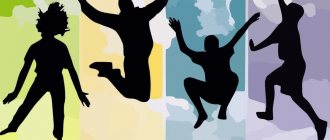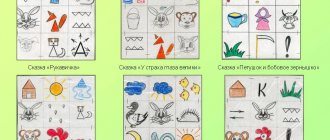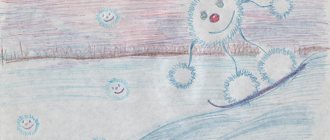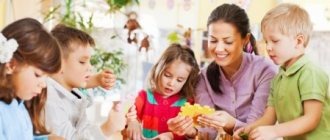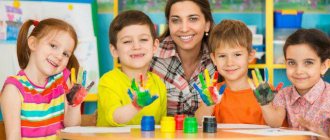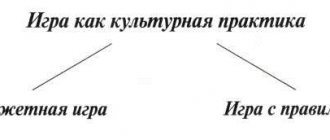Main types of joint activities between teachers and children
Time dictates change. We change, our environment changes. Modern society places new demands on the education system, including the first level – preschool education. And we need to learn how to organize the educational process in accordance with the provisions of the Federal State Educational Standard for Education.
One of the principles of the Federal State Educational Standard for Educational Education is the principle of assistance and cooperation between children and adults, recognition of the child as a full participant in educational relations.
The educational process includes 2 main components:
Joint partnership between an adult and children,
Free independent activity of the children themselves.
Lev Semenovich Vygotsky noted that the joint partner activity of an adult with children involves the child’s double motivation: on the one hand, the desire to be with the adult, to imitate him, to cooperate with him, and on the other hand, to do what is interesting. Partnership is, first of all, the equal inclusion of an adult in the process of activity.
Cooperative activity
– the basic model for organizing the educational process of preschool children. This is the activity of two or more participants in the educational process (adults and students) to solve educational problems in the same space and at the same time.
As part of the joint activities of an adult and children, problems
broad plan:
- development of general cognitive abilities (including sensory, symbolic thinking)
- development of children's initiative in all areas of activity;
- development of the ability to plan one’s own activities and voluntary effort aimed at achieving results, the task of the child mastering the “world order” in its natural and man-made aspects (building a coherent picture of the world).
Joint activities include:
- individual,
- subgroup,
- a group form of work with children and is carried out both in the form of educational activities and in the form of educational activities carried out during regime moments.
At the same time, the joint activity of an adult and a child is not only a stage in the development of any type of activity, but also a special system of relationships and interaction.
Joint activity between an adult and a child is, first of all, an activity during which emotional contact and business cooperation are established. It is very important to organize joint actions so that the teacher can call the child for verbal interaction or find lively, accessible reasons for the child to communicate. Organization and planning of joint activities must be flexible. The teacher must be ready for improvisation and for the child’s counter-activity. In the process of joint activity, the child gradually develops the position of a junior partner, guided by an adult and constantly taking into account the latter’s initiative. The joint activity of the teacher and children is based on the desire, characteristic of children, to participate in the real, “real” affairs of an adult.
The main areas of joint activity between teachers and children can be the following:
- project activities
- cognitive-game activity
- work activity
- associations of children by interests
- club activities
Depending on the type of joint activity between the teacher and children, there are various methods of interaction with them. The most common types of joint activities:
- Interaction in gaming activities
- Interaction in organizing problem-search (project) activities
- Features of interaction taking into account a gender approach.
1. The most effective in working with children are indirect influences, primarily influences through play and playful communication.
By entering into playful communication, the teacher gets the opportunity, in an economical way, to manage the activities of children, their development, regulate relationships, and resolve conflicts.
When joining the game, the teacher tactfully and carefully guides the players, taking care not to destroy their plan. At the same time, he solves various management tasks, which were identified taking into account the peculiarities of the game’s development. In order for children to realize a variety of ideas in games, the teacher must pay great attention to developing in them ways to realize their plans. Most children have well-developed objective ways of displaying their surroundings in a game, so the teacher only encourages them for their interesting invention in choosing an objective way to solve game problems. By forming role-playing methods, the teacher changes the forms of activating communication, he talks more with the players, encouraging them to role-playing statements and conversation, for this purpose he asks children questions about the content of the game. In gaming activities
children should be seen to be consistent and systematic, otherwise building a dialogue with children will be difficult and even problematic. For a teacher, play is a time to observe children, their actions, words, and interactions with peers. He must analyze the children’s play plans and see their experiences. Only in this case will he be able to correctly adjust the game and not disrupt its flow, which means he will interact organically with children. The teacher should come to play sessions with several games prepared in order to let them think about the theme of the game and let the children make their own choices. Skillfully help you stop at the most interesting. This develops their initiative. The teacher must recognize in time the children’s loss of interest in the game and support it with his actions. You can use new characters, change the tactics of the game, and give the children the opportunity to propose a continuation of the game based on their plot. And sometimes the teacher can become a full-fledged participant in the game, this really “turns on” the preschool children and makes the relationship between them closer. The skillful guidance of the teacher will make him a welcome participant in any games, and the game process itself will bring full fruit in the development of the preschooler.
2.
A preschooler cannot yet find answers to all his questions on his own; teachers help him.
Along with the explanatory and illustrative teaching method, teachers use problem-based learning methods
: questions that develop logical thinking, modeling problem situations, experimentation, experimental research, solving crosswords, charades, and puzzles.
Problem-based learning is characterized, first of all, by an independent search for solutions to various problems, promotes the meaningful assimilation of knowledge, the development of creative skills, independence, and activity. The child’s need for this method arises when it is impossible to solve the problem using known methods. In this regard, when developing the content of developmental education, especially close attention requires the selection of not only the knowledge that children must learn in the process of independent search activity, but also that which is intended for direct transmission. Joint activities, in this case, must be organized in such a way that the child’s special activity appears, so that children can argue, prove the truth, and communicate freely with each other. A person who is not accustomed from childhood to think independently, who assimilates everything in a ready-made form, will not be able to demonstrate the inclinations given to him by nature. In order for learning to contribute to the development of a preschooler’s thinking, it is necessary to use methods that will give the child the opportunity to comprehend the educational material. Reliance on a question that is significant for the child is necessary when a preschooler is faced with a contradictory choice, sometimes makes a mistake, and then corrects it independently. The problem-search method is especially prominent in pedagogy at present.
.
Organizing discussions stimulates the search for the right solution. The need to explain a friend’s methods of action involves all children in the process of solving the problem (even in cases where the child practically does not act). The creation of problematic situations, the constant cooperation of children with teachers allows you not to worry about maintaining discipline, there is no need to ensure that children are not distracted. With such an organization, no additional means are required to attract attention. At the same time, business cooperation arises within the children's team. Children are actively involved in the search situation, and in the process of solving a game or practical problem, they help each other. In addition, knowledge should involve children in solving problem-search tasks formulated on the basis of personal experience; activate cognitive interests, the desire to assimilate new information; stimulate mental activity (processes of analysis, synthesis, comparison, generalization and classification); increase levels of self-control, self-organization and self-esteem.
In order for activity not to weaken, along with clear, distinct knowledge, there must remain a zone of uncertainty. Let children independently look for solutions to the problems assigned to them, try, experiment, make mistakes and receive an unexpected answer to their questions. Satisfaction of curiosity should be combined with impatience to find out what will happen in the next lesson, with an attempt to express your hypotheses and assumptions. This problem-based learning strategy is built on the “principle of developing intrigue...”
The art of a teacher lies in the ability to correctly evaluate both correct and incorrect decisions, directing the search activity of children. The teacher should pay special attention to incorrect answers. By analyzing the solution path and the conclusion that was made with the children, the adult helps them understand their mistake and leads them to find a new way. First of all, the child’s cognitive activity should be encouraged. The organization of direct educational activities should help the child turn from a passive, inactive observer into an active participant.
3.
In preschool age, there is an intensive process of developing a child’s self-awareness, an important component of which is awareness of oneself as a representative of a certain gender.
The problem of gender socialization, which includes issues of the formation of the child’s mental gender, mental sexual differences and gender role differentiation, is one of the most important and pressing problems in education.
Gender education
- this is the formation in children of ideas about real men and women necessary for the normal and effective socialization of the individual. Under the influence of adults, a preschooler must learn the gender role, or gender model of behavior that a person adheres to in order to be defined as a woman or a man. By the age of 2-3 years, children begin to understand that they are either a girl or a boy, and identify themselves accordingly. At the age of 4 to 7 years, gender stability is formed: children understand that gender does not change: boys become men, and girls become women, and this gender will not change depending on the situation or personal desires of the child. Girls of preschool age are “more social” and more suggestible than boys; they cope better with simple, routine tasks, while boys are better at more complex cognitive processes. Girls are more influenced by heredity, while boys are more influenced by environment. Girls have more developed auditory perception, and boys have more developed visual perception and much more. The most favorable age period for starting gender education is the fourth year of life. Already in the fourth year of life, children whose behavior corresponds to correct gender education feel different from the opposite sex.
The role of kindergarten in gender education is very important, but still, it is obvious that raising children taking into account their gender characteristics will largely be determined by the individual characteristics of each child and depend on those patterns of behavior of women and men that the child constantly encounters in the family. In this regard, the primary task is to train educators to implement a differentiated approach to girls and boys, both when communicating with them and when organizing and leading various activities in the classroom and in everyday life. When teaching children, it is important for the teacher to take into account that girls need stimuli that are more based on auditory perception. Boys do not readily perceive the teacher’s explanation by ear and it is preferable for them to use visual means based on visual perception. When raising boys and girls together, a very important pedagogical task is to overcome the disunity between them and organize joint games, during which children could act together, but in accordance with gender characteristics. Boys take on masculine roles, and girls take on feminine roles. Theatrical activities can be structured in a similar way.
The successful formation of a child’s personality, his mental and personal developments occur only in the process of communication and joint activities with an adult. In these two spheres of life, the child’s intellectual and personal development, his orientation in the objective world and in the system of human relations are carried out. In the process of interaction with an adult, the child’s basic communication needs, which form the basis of a person’s personality, are satisfied. It is important that there is mutual respect .
Respect is a necessary element in the community that the kindergarten group is. Educators set the example of mutual understanding, respect and care for each other that they expect from children. The amount of respect children feel from others is a key factor in their development of self-esteem. And self-esteem, in turn, lays a strong foundation for positive relationships with other children. When teachers show respect for each child in the group, children learn to accept all other children - those who run slowly, those who draw well, and even children with unusual or conflicting behavior. When children see and feel that each of them is accepted and respected, they begin to feel comfortable and can behave freely and pursue their own interests.
Educators should realize that children, like adults, feel and notice the sincerity with which they are treated. Children should be praised for their work individually and sincerely, and interaction should be natural and relaxed.
Children embrace and respond to age-appropriate humor and fun. Adults should not be afraid that by laughing and joking with children they may lose control of order in the group. On the contrary, general fun only brings teachers closer to children, and the atmosphere of cooperation in the group is strengthened.
There is no upbringing without difficulties and problems. A teacher is first and foremost a person. With your feelings and needs. And education is a living process of human relations. Good parenting cannot take place without constant work on these relationships and without constant work on oneself. We love flowers, but without knowing the specifics of caring for them and without creating the necessary conditions for their growth, we are unlikely to wait for them to bloom.
Thus, modern approaches to organizing the educational process define the partnership position and partnership activities of the teacher with children as the basis for joint activities in a preschool institution, as a necessary requirement for the implementation of the Federal State Educational Standard for preschool education.
Municipal autonomous preschool educational
institution kindergarten No. 5 “Spikelet” of a combined type
village of Ermolaevo municipal district Kuyurgazinsky district
Republic of Bashkortostan
Main types of joint activities between teachers and children
Teacher of the highest category:
Sorokina N.A.
Ermolaevo village, 2020
Article:
The educational and educational process in preschool institutions is undergoing significant changes associated with restructuring in the field of pedagogy and modern trends in the approach to cooperation between adults and children. If earlier this meant a connection based on the “leader and follower” principle, now the joint activity of the teacher with children of different ages comes to the fore.
The concept of activity and its types for preschoolers
Human activity is the basis for the formation and development of personality. It is a special type of activity that promotes interaction with the outside world and helps to creatively transform oneself. Activities can be different - intellectual, creative, physical, and so on. For the successful development of children of different ages, various types of activities are used:
- Children from 1 to 3 years old are suitable for subject-based activities, individual and group games with peers and adults, outdoor games, elements of self-care, listening to fairy tales and music.
- Children from 3 to 7 years old have access to a greater number of types of activities, for example, a variety of games, communicative, research, cognitive and labor activities, self-care, visual and musical creativity, singing, physical activity.
Based on the characteristics of age, it becomes clear that the joint activities of the teacher with pupils in the middle age group of preschoolers are wider and more diverse.
Types of organization of children's activities in preschool educational institutions
There are the following forms of joint activity between the teacher and the children:
- Motor.
- Gaming.
- Fine (including design).
- Perception of folklore and fiction.
- Cognitive and research.
- Communicative.
- Self-care and age-appropriate household chores.
- Musical.
In order to encourage students to be active, competent organization of joint activities between the teacher and children is very important. The teacher must be able to win over group members and interest them without imposing his opinion. Pupils should act freely, without being forced into the play, work or cognitive process. Also important for them is freedom of movement, communication with each other and the teacher, the ability to work at their own pace, without being limited by a specific time period.
The joint educational activity of the teacher with children includes his activity along with his pupils. That is, the teacher should neither impose his attention on the children nor withdraw from influencing the game. If necessary, he can intervene, for example, help resolve a conflict between children, help someone with difficulties, and also contribute to the child’s integration into general activities.
Joint activities of the teacher with children and other preschool employees
Interaction should be present not only in communication between teachers and students, but also in the joint work of all categories of educators. For example, the joint activity of a teacher with a junior teacher provides preschoolers with the best conditions for staying in a kindergarten, since each of the preschool employees not only performs their professional functions, but also joins forces to achieve a joint result.
No less important in the educational process is the joint activity of the junior teacher with children. It contributes to the progress of children in the domestic sphere, self-care, self-knowledge, the formation of sustainable habits and useful skills. At the same time, the nanny works closely with the teacher, supporting him in all contacts with the children.
To achieve significant progress in correctional and developmental work, the joint work of a speech therapist and a teacher is also important. To do this, it is necessary that the specialist’s activities be successfully integrated into the general educational and educational process. At the same time, the age characteristics of individuals in need of correction are taken into account, and the teacher in every possible way supports the work of the speech therapist. In this case, the students treat the specialist much calmer and more loyal, which makes the correction process more productive, faster and more effective. Kids do not focus on shortcomings, but strive to achieve better results.
Working with parents and students
The joint activities of the teacher with children and their parents are equally important. It is impossible to carry out educational work and training only in kindergarten if at home the children do not receive the necessary information in the same way in which the teacher presents it. Parents and teachers of preschool educational institutions must work closely together to obtain an integral result and raise the child to be a full-fledged, developed, socialized and successful creative personality.
In the work of a preschool institution, a variety of topics are used in the joint activities of the teacher and children. They can be dedicated to various types of games, holidays, weather phenomena, puzzles and rebuses, construction, drawing and much more. Each of these projects of joint activity between the teacher and children has its own goal and direction. In order to cover the children’s interests as widely as possible, a cyclogram of the teacher’s joint activities is drawn up. It allows you to plan full-fledged activities for every day of the week, taking into account the age characteristics of children and allows you to harmoniously combine different types of activities. A supporting role is also played by a plan-outline of the joint activities of the teacher and children, thanks to which the teacher can control the correctness of the lesson at all its stages.
Joint activities make it possible to achieve a close partnership between teacher and student through a combination of activity and independent desire to understand the child and unobtrusive and delicate management of his interests on the part of an adult. Moreover, in such work there is no rivalry or oppression of one of the parties. When a child feels support, and not coercion or pressure from the teacher, he can develop more freely, while joining the society of his peers. That is why joint activities have such important goals and a significant role. It is important for all kindergarten students, but is especially in demand for the socialization, education and development of children with an introverted, problematic character, the presence of various characteristics and disorders, shy and timid. Often, in a team with an authoritarian leader and more active, energetic children, such students do not receive the necessary attention, do not join the team, and stay away.
When using the method of joint activity, it is possible to unobtrusively bring such children “out of the shadows”, reveal their potential, and activate their mental and physical capabilities. As a result, all members of the children's team receive the proper degree of attention. Children develop successfully and learn the basics of education and upbringing in an easy, accessible and useful way.
Development of a joint project of the teacher, children and parents
Family and kindergarten are the two most important institutions for the socialization of preschool children. In light of the implementation of the Federal State Educational Standard for Preschool Education, the relationship between kindergarten and family is defined by the concepts of “cooperation”, “interaction”, “partnership” .
Project activities, due to their specificity, are focused on creating conditions that reveal the creative and intellectual potential of preschool children, and are aimed at dialogical interaction between children, parents and teachers. Working on projects promotes self-knowledge and self-development of all participants in the pedagogical process.
Photo – Mezen Pedagogical College
Module B. “Interaction with parents (legal representatives) and employees of an educational organization” Task 1. Development of a joint project of the teacher, children and parents, preparation of a presentation about the stages of the project and its results using ICT for speaking about the project at a parent meeting.
Based on the characteristics of project activities in preschool educational institutions, participants were offered a task aimed at the following result:
1. A completed project passport for all subjects of the educational process of the preschool educational institution in accordance with the given topic (on paper).
- Presentation of the stages and results of project activities for all subjects of the educational process of preschool educational institutions using ICT, designed in accordance with a given topic, taking into account the presentation for an audience of parents of preschool children.
- Demonstration of the presentation to an audience of parents (volunteers with an acting task, voicing pre-formulated questions (30%) about the presentation for the participant during the presentation).
Photo – Mezen Pedagogical College
All competitors professionally and creatively approached the task, which required careful and fairly lengthy preparation (2 hours) and a brief presentation of the results of the work done as part of a fragment of the parent meeting.
It was amazing to see how the teachers managed to comprehensively, succinctly and vividly present all the stages and aspects of the jointly implemented project in the allotted 5 minutes.
The presentations of the competitors clearly demonstrate that they are fully proficient in the skills of implementing project activities in a preschool educational institution, understand its essence and significance, know how to methodically correctly organize work at the relevant stages of the project, distribute roles and responsibilities between participants.
Photo – Mezen Pedagogical College
The holiday of February 23 was chosen as the theme for joint activities, which was due to the time of year and the desire to increase the sense of patriotism in children. Therefore, this project had not only a practical result, but also important educational significance. Type of project: cognitive-creative, short-term in time (2 weeks), conducted in the senior group. Project products: matinee, exhibition of children's postcards, sports festival, wall newspaper, photo album “We Serve the Motherland.”
The competitors demonstrated project presentation skills, the ability to systematize and present information in various forms, including quantitative and statistical data in the form of diagrams.
Photo – Mezen Pedagogical College
It should be noted the warm, trusting relationship between teachers and parents, imbued with a mutual sense of gratitude. The teachers presented parents with letters of gratitude and tickets to the Local History Museum.
Volunteers plausibly and organically acted as parents and asked relevant questions: “What difficulties arose during the implementation of the project? What are the prospects for our future work? Will there be more joint projects? Have children begun to show interest in historical places?” The teachers' responses were only positive!
In general, we can say that an ideal model of interaction between the three sides of the educational process in kindergarten was presented during the implementation of joint project activities. And this is exactly the model our graduates will bring to life!
Mezen Pedagogical College
Project “Joint creative activity of children and their parents in the educational process”
MUDO Center for Additional Education of Children in Avsyunino
Orekhovo-Zuevsky urban district, Moscow region
Project
“Joint creative activity of children and their parents
in the educational process"
The author of the project is a teacher of additional education
highest qualification category
Kuritsina Elena Konstantinovna
2020
“Joint creative activity of children and their parents
in the educational process"
The key task of modern state policy of the Russian Federation is to ensure the spiritual and moral development and education of the personality of a Russian citizen.
“Spiritual and moral development and education of the individual begins in the family. It is family values, acquired by a child from the first years of life, that are of lasting importance for a person at any age and form the basis of civil behavior in society.”
Parents play a vital role in a child's life. Parental love is the source and guarantee of human well-being, maintaining physical and mental health. That is why the first and main task of parents is to create confidence in the child that he is loved and cared for. Deep, constant psychological contact with parents gives the child the opportunity to feel and realize parental love, affection and care.
The basis for maintaining psychological contact is a sincere interest in everything that happens in a child’s life, sincere curiosity about his childhood, even the most trivial and naive, problems, a desire to understand, a desire to observe all the changes that occur in the soul and consciousness of a growing person. It is necessary to communicate with children from a young age: without communication, without constant concern for arranging common leisure time and common affairs with them, parents will not be interested in their own children.
The main values of educational activities in the system of additional education are the child, his development, childhood as the special life of a child, educational space as an environment conducive to personal development. Therefore, additional education has great potential to help parents establish and maintain psychological contact with the child, spiritual and moral development and education of all participants in the educational process.
One of the forms of interaction between additional education institutions and students’ families is family clubs and workshops. Organized joint creative activity is the inclusion of the parent in the child’s activity. This is a situation in which a child, faced with a certain difficulty, has the opportunity to turn to a parent for help. And the parent gets the opportunity to do the work together with the child. As a result of joint creative activity and common interests, the child and parent reach mutual understanding and become closer to each other.
